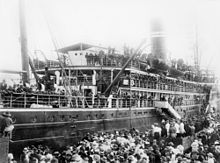Sealed orders refer to directives presented to the commanding officer of a ship or squadron that are sealed at time of receipt. Officers are required to keep the orders sealed until at sea so as to maintain operational secrecy, especially in time of war.[3][4]

References
edit- ^ Frederick Spencer Burnell (1915), How Australia Took German New Guinea, Angus & Robertson
- ^ Anzac Memorial, Returned Soldiers Association, 1916, p. 92
- ^ A naval encyclopædia: comprising a dictionary of nautical words and phrases: biographical notices, and records of naval officers: special articles of naval art and science. Harvard University. Philadelphia, L. R. Hamersly & co. 1881.
{{cite book}}: CS1 maint: others (link) - ^ One or more of the preceding sentences incorporates text from a publication now in the public domain: Wood, James, ed. (1907). "Sealed Orders". The Nuttall Encyclopædia. London and New York: Frederick Warne.